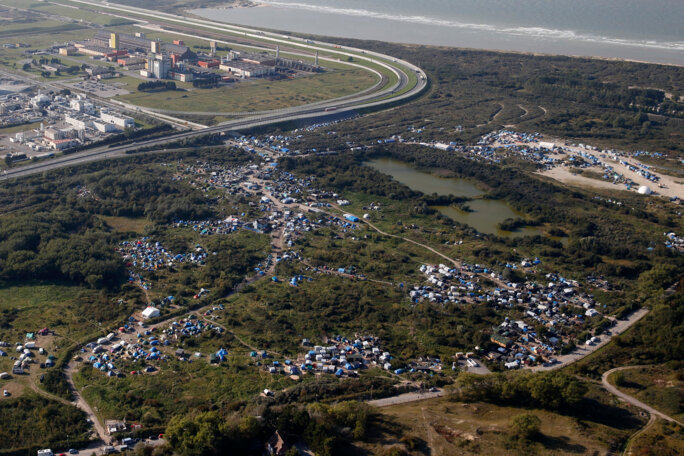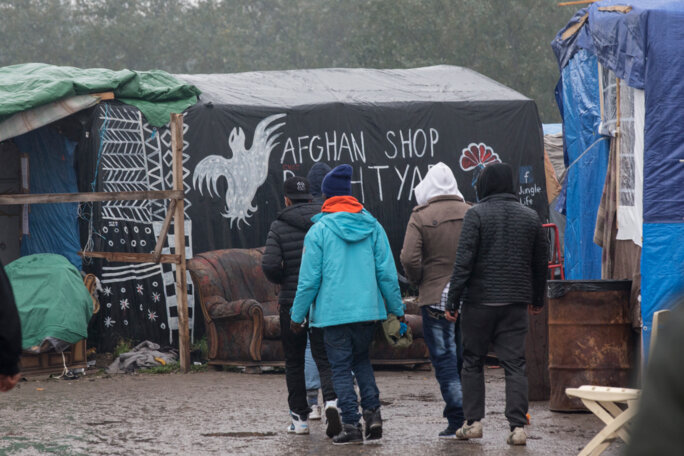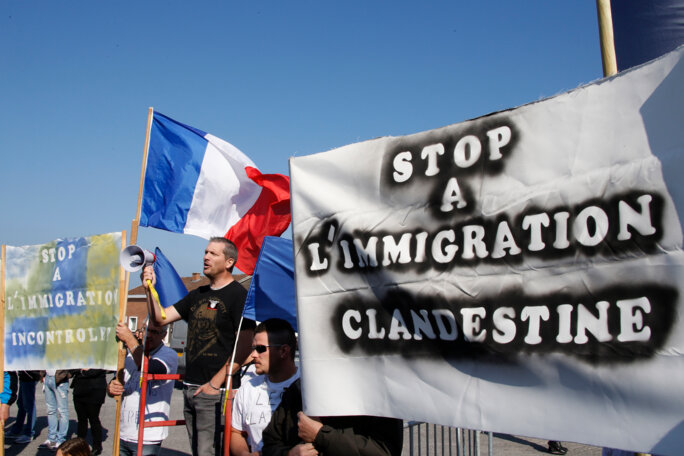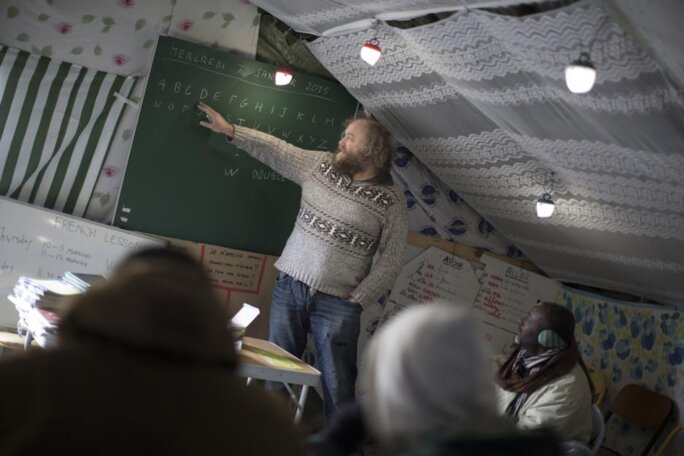
By day, they cross paths with them on the streets of Calais. At night they know that they will be out trying their luck at getting from this northern French town to Britain. So what do the people of Calais – les Calasiens as they are known in French – really think of the people they call “the migrants”? In this port town of 75,000 inhabitants, which was communist-run until 2008 and is currently under the control of of the Right, the presence of these migrants has become a major issue. But the reality is that few locals know how the 6,000 or so migrants, cooped up in a muddy camp on the outskirts of the town, really live.
On the Route de Gravelines, a few hundred metres from the so-called 'New Jungle', the local name for the shanty town where the migrants live, Ghislaine parks her car in front of her small white house. The migrants? “We don't have a problem with them,” says the pensioner, a former care assistant. A few years ago she gave them “some clothes, water, shoes, something to eat”. Yet though she says they are not a problem, she refuses to let her granddaughter take the bus to her middle school or collège from here, because the bus route that goes from the shanty town to the Channel Tunnel “is heaving with foreigners”.
Her husband Robert, who worked as a manager in the steel industry, says he has noticed migrants congregating in front of his hedge on some evenings, all of them busily consulting their smartphones. “I realised in the end that they are using my wifi. That doesn't worry me, but they talk loudly. When I turn it off they eventually leave,” he says, a little embarrassed.
Like many Calais residents Ghislaine is full of ambivalence about the migrants, admitting she is both “with and against” them. First of all, she is “against the system that doesn't find a solution”. Then she also considers that the migrants “make themselves a little too much at home”, for example “when they squeeze the bread” at the Lidl store on rue Molien. She turns towards her husband Robert. “What's the name of their country where there is the war?”
“Syria?” he asks.
“Yes, Syria,” she says. “They should stay over there. The guys, they should take up arms, they shouldn't give everything up.”

Enlargement : Illustration 2

'They' are Sudanese, Eritreans, Afghans and Iranians as well as Syrians. The people of Calais see them from a distance. From the motorway they can see the blue plastic huts and the four-metre fences topped with razor wire that enclose the ring road and access to the port, and which gives the place the impression of being an entrenched camp. The locals pass migrants who walk on the hard shoulder of the motorway or ride their bikes in the town. They see the news on the television or on social media: lorries under siege on the ring road, migrants nose to nose with a polar bear in a lorry, the fights in the 'jungle'.
There are rumours of attacks, thefts, and then there is the litany of deaths among those who are trying to get across to Britain, their grim fate casting a dark shadow over the town. On October 15th it was a 26-year-old Syrian woman, Nawal, who died, knocked down on the A6 motorway by a taxi that did not stop, Le Monde reported. The following day a 16-year-old Afghan boy was smashed to pieces by a freight train close to the tunnel. In all 19 migrants have died here in 2015, including three women and four minors. They have been knocked down by local trains, drowned in local ports and crushed under local lorries. But the longer the list grows, the more remote they seem.
A short distance away Mediapart meets a jobbing butcher, Jean-Charles, dressed in fatigues, busy spreading some sand in front of his house as the rain pours down. He sees the migrants morning and evening, by the dozen, going to and coming back from the tunnel. He also comes across them when he is out hunting, near the former Jules Ferry outdoor centre which has now become a place where migrants can get meals and a shower, plus some heath care, where they can get their mobile phones charged, and where some women migrants stay. “They don't bother me,” says Jean-Charles warmly. “I say hello and they say hello.” But he struggles to understand them. “They walk over half of the road, we have to push through. Even on bikes they are dangerous. If we have an accident, who will be in the wrong? It will be us. Some even cross the motorway.”
They cross the motorway to get to the tunnel, cutting through the green space between the carriageways. Jean-Charles knows that they found the body of a Moroccan in the sea at Gravelines. “I read it in the newspaper,” he explains. The young man's body had drifted there after he had drowned in Calais port, trying to swim to a ferry. Jean-Charles cannot believe it. “Would you jump in the water in that weather? When it's 6 to 7 degrees? You seize up! I go shrimp fishing, I don't go in the water without a wetsuit.”
Like many people, he blames all these tragedies on the traffickers. “They're selling dreams. They make people think they can go to England like a letter in the post. [The migrants] pay to get themselves killed.” Yet those who hurl themselves into the water or on to trains no longer have money to pay traffickers. “They're crammed in there with children.” Jean-Charles is indicating the direction of the 'jungle', behind the bridge. “I'm not racist but it's no place for kids.” Once his teenage daughter was “attacked” at the bus stop. There were four or five of them and they had been drinking. “She ran off. Fortunately it stopped at that.” He leaves pallets and chairs in front of his house for the migrants. “I don't like them to help themselves. There are some who ring the bell, they ask me. Then I say okay.” When Jean-Charles was renovating the front of his house with white bricks some of the passing migrants complimented him on the work, in English. “'Good, good' they said to me.” He raises his thumb.
The New Jungle – the Calais district's third biggest town
In the town they have become almost invisible. Shop owner Carole scarcely sees them from her shop in Calais-Nord, one of Calais's two “town centres”. Apart from during some demonstrations. “That's the only problem. There were quite a few of them. They block the town, that stops us from working.” She also gives clothes and shoes, and pallets to help make huts. But “there are too many of them, we are overwhelmed”.
The townsfolk are overwhelmed, too, by the image of suffering that Calais is giving out to the world. “Journalists paint a very negative picture. This summer we had fewer tourists, that caused harm.” One weekend she was in Holland where people said to her: “Calais? Oh, well, the things you must see there!” She sighs. “As if the town was a cut-throat area! It's true that when you see the riot police, the migrants, the lorries, in people's minds the town is at war.” Carole glances out at the street. There is no one there, just a gust of wind blowing her shop's sign. She has lost 30% of her turnover.
It's the same story with Mireille, another shopkeeper. She doesn't complain and speaks about the migrants with tenderness. She thinks that they have “nice faces”. She says hello to them when she meets them while driving and loves the smiles they give her. “When people moan I say to them 'Imagine if that happened to you'.” She does not understand why they are demolishing the former hospital in Calais town centre, where they would be able to “house lots of people”.
Another shopkeeper, Claude, also has nothing against the migrants - “what they are experiencing is inhuman” - but does blame “the traffickers, who line their pockets and strut around town”. What worries him most of all are the people of Calais, and the impact the crisis has had on them. “We were firmly on the Left, communist for many years, and then, there you go, the [far-right] Front National (FN) were just a few votes from winning a district against the Right, and with an unknown and uncharismatic candidate.”
In the working class Beau Marais part of town, which is a former communist stronghold and according to the state statistical agency INSEE the poorest area in the entire département or county of Pas-de Calais, the FN came top in the local elections in March 2015, winning 65% of the votes in some voting stations. In Calais residential areas within the Calais 2 voting district the FN candidate won 54.8% of the votes against a socialist rival. Marine Le Pen's party almost won overall in the Calais 3 district, picking up a 49.5% share of all the votes cast. The town hall points out that unemployment has recently gone up to 16.5%, with the situation made worse by job losses at the ferry company MyFerryLink.
At a bus stop in Beau Marais two “stay-at-home mums” get worked up when the subject of migrants is raised. “They annoy us,” says the older of the women. In what way, exactly? “They look us up and down from head to toe.” She adds: “When they go to the post office they take out 200 euros while we have to budget our shopping to the nearest centime. They push trolleys full of beer and we slave away to feed our kids.” The trolleys full of food and beer, which the migrants push as far as the 'jungle', are provisions that will later be sold retail on stalls.
For the 'jungle' has now become its own little town, with places of worship, restaurants, schools, a library and even some small nightclubs. The number of people living in the shanty town has grown to more than 5,000, even 6,000 according to the local state prefect, Fabienne Buccio, who announced new figures in mid-October. According to the regional newspaper, La Voix du Nord, this would make the shanty town the “Calais area's third [biggest] town”.

Enlargement : Illustration 3

In an attempt to fight against preconceived ideas and rumours, photographer Julien Saison organised a meeting in November 2014 at the town's university library between local middle school pupils and Sudanese migrants from Darfur, Eritreans and Afghans. “These pupils were the spontaneous and naïve reflex of what their parents think,” says Saison. “For example they asked 'why do we give them 80 euros a day each?'” He had to explain to them that the migrants in Calais do not receive anything. And also that they have sold everything or gone into debt just to get here. And that only asylum seekers receive just under 12 euros a day.
The migrants at the meeting spoke about the reasons why they had left their homes, their travelling companions who had died of thirst in Libya, and of their previous lives. The pupils spoke about assaults and thefts that they had not themselves seen, but which they had been told about. Julien Saison recalled the response of one migrant, who said: “Some of us sometimes drink a little too much alcohol and become aggressive, but I also saw French youths fight one evening coming out of a bar.” The photographer said: “At the end the [pupils] said to them 'good luck, we understand you'.”
The question is, how does one forge contacts between the two communities? “We'd like to inform people, re-establish some truths,” says Coline, who works for a local group, Le Réveil Voyageur, that helps migrants. “We don't know how to proceed. Meetings, debates with a drinks reception, a drinks reception with something else...” Le Réveil Voyageur tried having a stall at the local market one day, selling tea and madeleine cakes, but it did not work. “The weather was cold and grey, perhaps that didn't help,” says Coline.
'Most thefts and assaults take place in the jungle'
The atmosphere in the town grew more tense two years ago. In October 2013 around 350 migrants were living in squats in the town, 17 times fewer migrants than are there today. The town's right-wing mayor Natacha Bouchart put out a message on Facebook asking people to “inform” the authorities about squats, using a dedicated email address. She wanted to “provoke things a little” she told news agency AFP. “As it's in the town centre there are also people who have trouble understanding these squats.”
The following day Philippe Wannesson, a Mediapart blogger and president of the now defunct migrant help group La Marmite aux Idées, noted that “informing” already existed between neighbours. “There are many examples involving people receiving exiles into their homes, which lead to police procedures in relation to the neighbourhood and homeowners, sometimes conducted in a repeated and insistent manner.” Since then Natacha Bouchart, who is also a senator for the right-wing Les Républicains (formerly the UMP), has succeeded in getting an anti-squat law adopted almost unanimously by the Senate and National Assembly. This measure removes the former 48 hour time limit, after which no one could evict squatters simply on the grounds that there was an ongoing offence.
Another new development in the autumn of 2013 was the emergence of an extreme-right group called Sauvons Calais ('Save Calais'). This is led by a 20-year-old called Kevin Rèche, an activist who lists Alexandre Gabriac – the founder of the extreme-right national group Jeunesses Nationalistes and who was excluded from the FN after being photographed giving a Nazi salute – as one of his “idols” and who has a swastika tattooed on his chest. In February 2014 this group enlisted some residents from the village of Coulogne, near Calais, and created another group called “Riverains en colère” ('Angry local residents'). The members of this group, many sporting shaven heads, raged against a “migrant squat” in an abandoned house.
As the local newspaper Nord Littoral pointed out, the squat contained no migrants, simply two French citizens and a Briton. Nonetheless around 70 persons gathered to threaten and insult the occupants and throw stones. The protesters burst through the gates and broke some of the windows. On Sauvons Calais's Facebook page someone wrote: “For one Kosovan killed, a free box of cartridges.” The reference to Kosovo stems from the fact that the first migrants in Calais at the end of the 1990s were people fleeing the Kosovo War. The house's barn was set alight, and the squatters left. Revulsion at this episode led to the creation of another group, 'Calais, ouverture et humanité' ('Calais, openness and humanity') run by, among others, Mediapart blogger Séverine Mayer.
Sauvons Calais's moment of glory came at a demonstration on September 7th, 2014. This saw protesters giving Nazi-style salutes in front of the town hall, with some of the demonstrators, who came from across the country, sporting the badge of the Charlemagne Division, the French volunteer section of the German SS in World War II. On the internet there were calls to murder migrants. The prosecutor at nearby Boulogne-sur-Mer opened an investigation into incitement to racial hatred.
Now yet another group has been formed, calling itself Les Calaisiens en colère ('Angry Calais residents'), which includes several people who live near the 'jungle'. According to La Voix du Nord the group, which describes itself as “apolitical” and “non-racist”, allowed two former FN election candidates for the town council to address a demonstration on Sunday October 4th, 2014. This protest, which was banned by the mayor but approved by the state prefect, featured slogans such as “Calais for Calais people”, “France for the French” and “This is our home”.

Enlargement : Illustration 4

The following month police officers took to the streets, and used the columns of the Nord Littoral to criticise what they called the “new behaviour on the part of the migrants”, in a bid to get police numbers boosted. Around this time there were a number of reports of sexual assaults and thefts of mobile phones, with victims singling out migrants as the culprits. This was a new development, perhaps explained by the growing number of migrants in the town. There were around 2,000 in Calais at the time. In one incident the boss of a hair salon said five migrants had stolen around a hundred euros and some shampoo. One of the men had pushed the woman, causing her to fall.
The hair salon boss later spoke about the incident in a measured way on the 'Les Pieds sur Terre' programme on France Culture radio. “As they mustn't have anything left, they start to steal. I'm not going to say that I understand them, because it's not right. But I can't be against them because, after all, it is distressing to see people wandering the streets like that with nothing.” Today she adds: “I think that they were a bad bunch who were there at the time.”
François Guennoc, from the migrant aid group the Auberge des Migrants, points out: “Most of the thefts and assaults take place in the 'jungle', between refugees. The theft of documents, the theft of shoes and extortion. They can demand 200 euros from someone to give them back some documents.” There are also cases of violence against women which are difficult to evaluate. There are currently 1,300 police officers in the Calais area, including those who patrol the 'jungle' itself. Speaking on RMC radio on Monday October 19th, 2015, Calais mayor Natacha Bouchart called for the army to be present on the ground. “It would not be inappropriate for the army to come to keep watch, to reassure, perhaps also dismantle some [criminal] networks,” she said. That same evening she issued a press release demanding that a bill “voted through by the Senate and which obliges migrants to identify themselves through photographs or by taking their fingerprints, should be quickly put in place”.
Migrants are a source of 'cultural richness' says mayor
Compared with the actions of some migrants, the violence committed by a handful of locals against migrants is on a different scale altogether. Since June 2015 at least nine Africans have been beaten up by a group of three people, two men and a woman. According to Libération they drive around in a black car. One of the victims was left unconscious and seven of them have so far filed formal complaints. Yet the police investigation is not progressing quickly. Gilles Debove, secretary of the Force Ouvrière union branch of the police in Calais, says: “The victims don't respond to summonses! It seems that they're afraid that we'll take their fingerprints. Does one take fingerprints from people who make complaints? Has no one told them?”
François Guennoc from the charity Auberge des Migrants recalls having tried in vain convince one victim. “We indeed told him that he risked nothing, we were insistent, there was nothing to be done.” But other victims have agreed to give statements. In June 2014 a security guard, Frédéric D., fired a shotgun with armour-piercing pellets at a Sudanese and an Eritrean, wounding them. He was jailed for six months.
In recent months demonstrations involving 300 to 400 people, including Syrians, Iranians, Afghans and Sudanese, have crossed the town, with protesters demanding to go to Britain without risking death and enriching traffickers. The demonstrations pass through the Place d'Armes, go past the port and then parade in front of the town hall, sometimes on a Saturday when weddings are being held there. This exasperates the mayor. Natacha Bouchart speaks of a “public nuisance” and accuses the freedom of movement group No Borders of manipulating the migrants, a claim they reject. “The demonstrations always start at the initiative of a group of exiles. The activists print the flyers and communicate the information to other groups of exiles,” says a woman from Le Réveil Voyageur, and who is close to No Borders. “It strips the migrants of all credibility to suggest that they don't think for themselves.”
The mayor favours neither No Borders on the one hand nor the groups Sauvons Calais and Calaisiens en Colère on the other, banning their demonstrations, sometimes against the advice of the prefecture. At the same time Natacha Bouchart – who is head of her party's list for the Pas-de-Calais in December's elections in a region where Marine Le Pen is head of the FN list – has stepped up her anti-FN declarations. She has also repeatedly insisted that the migrants represent a source of “exceptional cultural richness” for Calais.

Enlargement : Illustration 5

This is the same mayor, though, who managed in March 2015 to get the state to move the migrants out of the town itself and into a former rubbish tip next to three functioning chemical factories, and part of which is, according to the news agency AFP, in a zone classified as subject to potentially hazardous products. This 'New Jungle' is close to the former Jules Ferry outdoor centre. At the end of March it was the sub-prefect in person who toured the squats and told migrants that they would only be tolerated in this camp. So despite the protests from help groups and association who had urged the provision of “small units” managed by UNHCR-style organisations, the sprawling 'New Jungle' became the migrants' official home. It is an an expanse of sand and dunes buffeted by the winds, on ground that quickly becomes muddy as soon as it rains and which promises to be a tough place to live this winter. Already, by the middle of October, the temperature had dropped to a chilly 5 degrees Celsius on some nights.
Humanitarian workers say that each day between 15 and 100 migrants manage to make it to England, while another 100 to 200 arrive each day at the 'jungle'. As it has got harder to get across to England, so the rates charged by traffickers has increased too: the going rate is 1,000 to 1,500 euros for a standard passage attempt, and around 6,000 euros for a specially-adapted lorry and a willing driver.
And while they wait to get across, these neglected migrants remain in the Calais camp, a location which can only add to their hardship and trauma. Lou Einhorn Jardin is a psychologist with medical charity Médecins du Monde and sees 20 to 25 migrants in the camp. She deals with the effects of recent traumas, such as war and torture in their homeland, but also with older traumas that are reawakened because of what happens in Calais - for example police violence and the expulsion of friends back to the Sudan.
Lou Einhorn Jardin is on hand to help the grieving each time there is a death, against a backdrop of the stress caused by this absurd life in the cold and the mud, with people stranded just a few dozen kilometres from their goal. “It's strange to see people for consultations in a camper van, in a shanty town, and to tell yourself that their psychological problems are in part due to the living conditions in this very same shanty town,” says the psychologist.
-------------------------------------------------------------------
- The French version of this article can be found here.
English version by Michael Streeter


